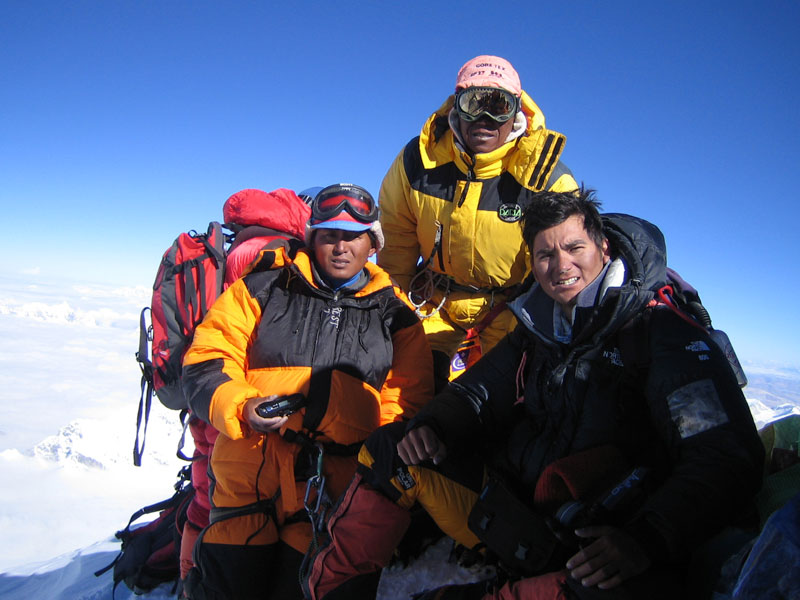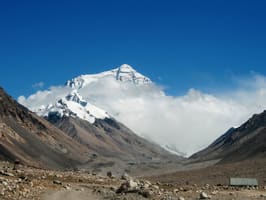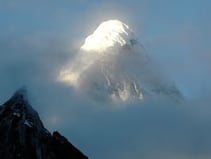
Mount Lhotse
Lhotse is best known for its proximity to Mount Everest and at 8,516 metres it is the 4th highest Peak in the world. The climbing route for the Lhotse Expedition follows the same route as the climb on Everest, including the aptly named Lhotse face almost all the way till Everest’s Geneva Spur from where it follows a steep climb through a long couloir to the summit.
Lhotse has three summits, of which the lowest is 8,383 metres high (Lhotse Shar). Next in order of altitude is Lhotse East, also known as Middle, standing at the height of 8,413 metres. The highest peak at 8,516 metres is called Lhotse Main. It was reached for the first time in 1956. Interestingly, the first successful ascent on Lhotse Middle was only in 2001.
Leading the way to the summit is the Lhotse Couloir. It is located on the west face, or the Lhotse Face, of the mountain. The couloir is a massive ice gully, and presents the most challenging part of the climb for the expedition members. At certain points its rise is as steep as 80 degrees. It features two rocky areas – the Yellow Band and the already mentioned Geneva Spur. Apart from demanding terrain, climbers going through the gully have to be wary of periodic snowfall.
Climbing Lhotse – what you need to know about expedition
Lhotse expedition – general information
Climbing Lhotse is an excellent alternative to the Everest Expedition while being much more affordable since the permit fees are much lower while offering a similar climb. Though it is often seen as a minor eight-thousander, Lhotse is a dramatic peak in its own right, due to its tremendous south face which rises 3.2 km in only 2.25 km of horizontal distance, making it the steepest face of this size in the world. The south face has been the scene of many failed Lhotse expeditions, some notable fatalities, and very few ascents. Climbing Lhotse can be done as an add on during an Everest expedition as well, since the two peaks are connected by the South Col.
Expedition overview
The whole expedition is planned to last 56 days. Kathmandu is the starting and ending point of the whole journey. Along the way, you will visit the Namche Bazaar, pulsing with local tradition, as well as the main Buddhist centre in the region – the Tengboche Monastery. From there, you will start the actual climb with high camps on the route. It takes 4 days to reach the foot of Mount Everest and the Everest Base Camp trek is highly popular. It offers picturesque panoramas of the surrounding mountain ranges and forests.
The Lhotse expedition route progresses through the Khumbu icefall. It follows the same path as the standard Everest ascent, up to a point above the Yellow Band. Then, the routes diverge – Everest climbing parties head to the left of South Col, and Lhotse climbers turn right.
For specific information about the schedule, see the detailed itinerary down below.
Your mountain guides
At Asian Trekking, we make sure to provide you with the best conditions to take on the challenge that is before you. We take care of the organizational matters, so that you can focus solely on reaching the summit. Climbing with us, you are supported by experienced climbing Sherpas in your ascent. Having them in your camp staff ensures the best possible guidance and assistance. The Sherpas help in the camp setup, load carrying, and, most importantly – the climb itself. Additionally, safety measures are of utmost importance to us. We never compromise when it comes to danger, always putting the climbing party’s health and life first.
You can expect breathtaking views and unforgettable adventure, but all this is possible only if we protect the mountains. Asian Trekking is dedicated to cleaning the slopes. We remove tons of rubbish as we climb, as well as raise awareness about environmental problems.
Who can climb Mt Lhotse?
Are you ready to face ten-hour treks and climbs day to day? Excellent physical condition is an absolute must during this expedition. The climbing stretches are a challenge, with severe weather conditions and altitude above 8,500 metres. Be prepared to climb on difficult, remote, extremely rocky and icy terrain. The climb requires technical mountaineering equipment.
Overview
The mountain
- Its east-west crest neighbours directly with Mount Everest
- Three peaks: 8,383 m, 8,413 m and 8,516 m
- 4th highest mountain in the world
- Extremely steep ice gully, rising 3.2 km
The Lhotse Expedition
- Trip duration: 56 days
- Sherpa villages and Buddhist centre visits planned
- Includes steep glacial wall on a 2.25 km stretch
- Extreme weather conditions
Why climb Lhotse?
- A perfect challenge for technically advanced mountaineers
- Unforgettable experience of local culture on the route
- The best preparation for Everest ascent
- A cheaper alternative to Mount Everest ascent, with similar conditions
- Excellent logistics and the highest safety standards provided by Asian Trekking
For more information and advice, click the “Ask for details” button in the top left corner. You can either fill in a contact form or write to our travel experts directly.
Info about skydive in Himalaya
Check also the best trekking in Nepal
















